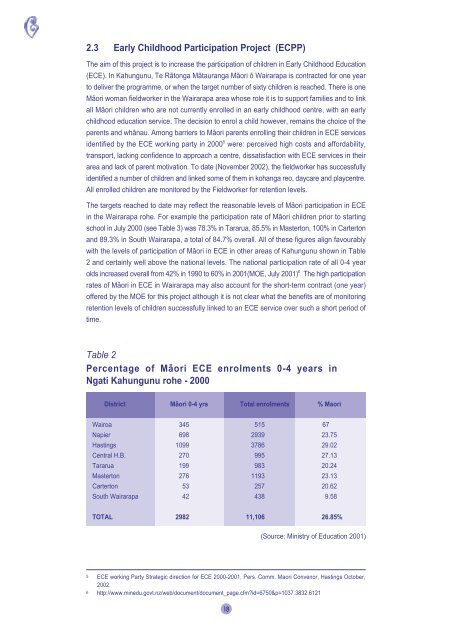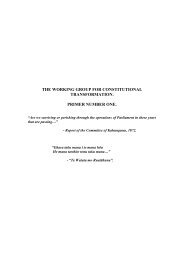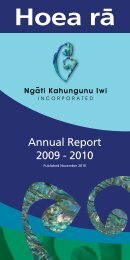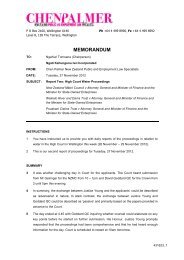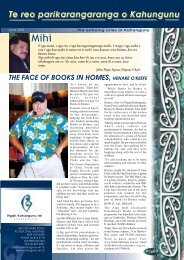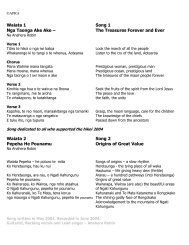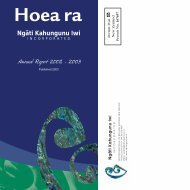Matauranga Strategy - NgÄti Kahungunu Iwi Incorporated
Matauranga Strategy - NgÄti Kahungunu Iwi Incorporated
Matauranga Strategy - NgÄti Kahungunu Iwi Incorporated
Create successful ePaper yourself
Turn your PDF publications into a flip-book with our unique Google optimized e-Paper software.
2.3 Early Childhood Participation Project (ECPP)<br />
The aim of this project is to increase the participation of children in Early Childhood Education<br />
(ECE). In <strong>Kahungunu</strong>, Te Rätonga Mätauranga Mäori ö Wairarapa is contracted for one year<br />
to deliver the programme, or when the target number of sixty children is reached. There is one<br />
Mäori woman fieldworker in the Wairarapa area whose role it is to support families and to link<br />
all Mäori children who are not currently enrolled in an early childhood centre, with an early<br />
childhood education service. The decision to enrol a child however, remains the choice of the<br />
parents and whänau. Among barriers to Mäori parents enrolling their children in ECE services<br />
identified by the ECE working party in 2000 5 were: perceived high costs and affordability,<br />
transport, lacking confidence to approach a centre, dissatisfaction with ECE services in their<br />
area and lack of parent motivation. To date (November 2002), the fieldworker has successfully<br />
identified a number of children and linked some of them in kohanga reo, daycare and playcentre.<br />
All enrolled children are monitored by the Fieldworker for retention levels.<br />
The targets reached to date may reflect the reasonable levels of Mäori participation in ECE<br />
in the Wairarapa rohe. For example the participation rate of Mäori children prior to starting<br />
school in July 2000 (see Table 3) was 78.3% in Tararua, 85.5% in Masterton, 100% in Carterton<br />
and 89.3% in South Wairarapa, a total of 84.7% overall. All of these figures align favourably<br />
with the levels of participation of Mäori in ECE in other areas of <strong>Kahungunu</strong> shown in Table<br />
2 and certainly well above the national levels. The national participation rate of all 0-4 year<br />
olds increased overall from 42% in 1990 to 60% in 2001(MOE, July 2001) 6 . The high participation<br />
rates of Mäori in ECE in Wairarapa may also account for the short-term contract (one year)<br />
offered by the MOE for this project although it is not clear what the benefits are of monitoring<br />
retention levels of children successfully linked to an ECE service over such a short period of<br />
time.<br />
Table 2<br />
Percentage of Mäori ECE enrolments 0-4 years in<br />
Ngati <strong>Kahungunu</strong> rohe - 2000<br />
District Mäori 0-4 yrs Total enrolments % Maori<br />
Wairoa 345 515 67<br />
Napier 698 2939 23.75<br />
Hastings 1099 3786 29.02<br />
Central H.B. 270 995 27.13<br />
Tararua 199 983 20.24<br />
Masterton 276 1193 23.13<br />
Carterton 53 257 20.62<br />
South Wairarapa 42 438 9.58<br />
TOTAL 2982 11,106 26.85%<br />
(Source: Ministry of Education 2001)<br />
5 ECE working Party Strategic direction for ECE 2000-2001, Pers. Comm. Maori Convenor, Hastings October,<br />
2002.<br />
6 http://www.minedu.govt.nz/web/document/document_page.cfm?id=6750&p=1037.3832.6121<br />
18


